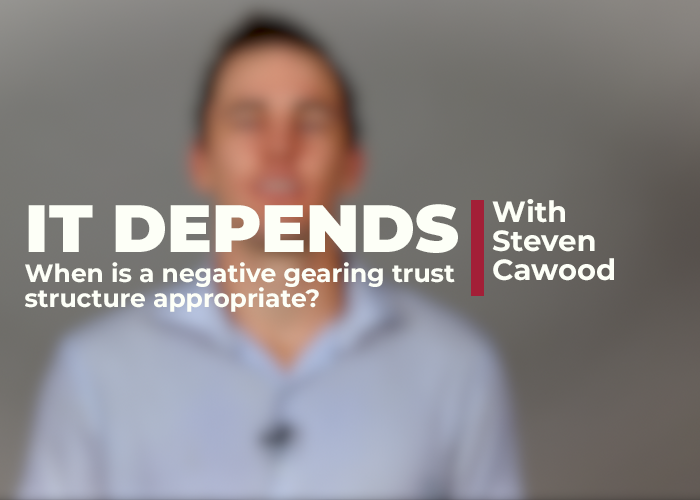In this edition of ‘It depends’, graduate Steven Cawood talks about negative gearing trust structures and, in particular, what they are and when they’re appropriate.
Video Transcript
Welcome to this instalment of It Depends. Today I’ll be talking about a negative gearing trust structure and in particular what they are and when they’re appropriate.|
What is negative gearing?
Negative gearing occurs when a loan is taken out to purchase an income producing asset most commonly a property. However, it produces insufficient income to cover its costs such as interest on the loan or the loan repayments. The effect of this for the individual or the entity which holds the asset is that the loss can reduce their assessable income and therefore may result in a tax benefit. Whilst initially this means they may sustain some losses it can be an effective investment strategy for assets that increase in value over time.
What is a negative gearing trust?
A negative gearing trust may be used where by an individual borrows money from the bank and then uses those borrowed funds to make an interest free loan to a negative gearing trust. A trust with very particular provisions. The trust then uses these funds to purchase an investment asset. The trustee does not have to pay interest on the funds it borrows from the individual. However, the trustee of the trust must make distributions to the individual who made the loan. The amount of the distributions will be the lesser of the trust’s net income in each year and the interest paid on the loan. Distributions must be made to the individual until the total amount of the distributions equal the interest paid on the loan.
Who is a negative gearing trust structure appropriate for?
A negative gearing trust is intended to assist high-risk and high-income earning individuals who wish to claim negative gearing deductions for loans in their own name whilst protecting assets from claims against them.
Why do people use negative gearing trust?
Well it depends. Firstly, for asset protection. The asset will not be held in the individual’s name but instead in the trust. As such, the equity in the asset acquired in the trust could be substantially protected against claims against the individual especially if there is a corporate trustee of the trust. Secondly, individuals use it to obtain a tax deduction for borrowings made in their own name. Generally, individuals cannot claim a tax deduction for interest expenses incurred for assets held in discretionary trusts. A negative gearing trust is a special type of trust where an individual may be able to obtain a tax deduction for interest expenses incurred on the bank loan even though the asset is in the discretionary trust. The net income in the trust will be substantially less than the interest payable on the loan in the early years. This means the individual will get a tax deduction for substantially all of the interest payable on the loan. Thirdly, individuals use a negative gearing trust to give them flexibility to deal with surplus income and capital of the trust. Under our negative gearing trust structure any income that exceeds the interest payable on the loan can be distributed to a discretionary trust. From this discretion trust the trustee can then distribute that surplus income in any manner it pleases. Similarly, any capital gains can be distributed to any beneficiaries under the trust. It doesn’t have to be the actual individual that made the initial loan to the trust. This is the case provided they recouped all the interest paid to the bank. Thank you for listening to this instalment of It Depends. Please contact a member of our team if you need help with negative gearing trusts or trusts in general.






